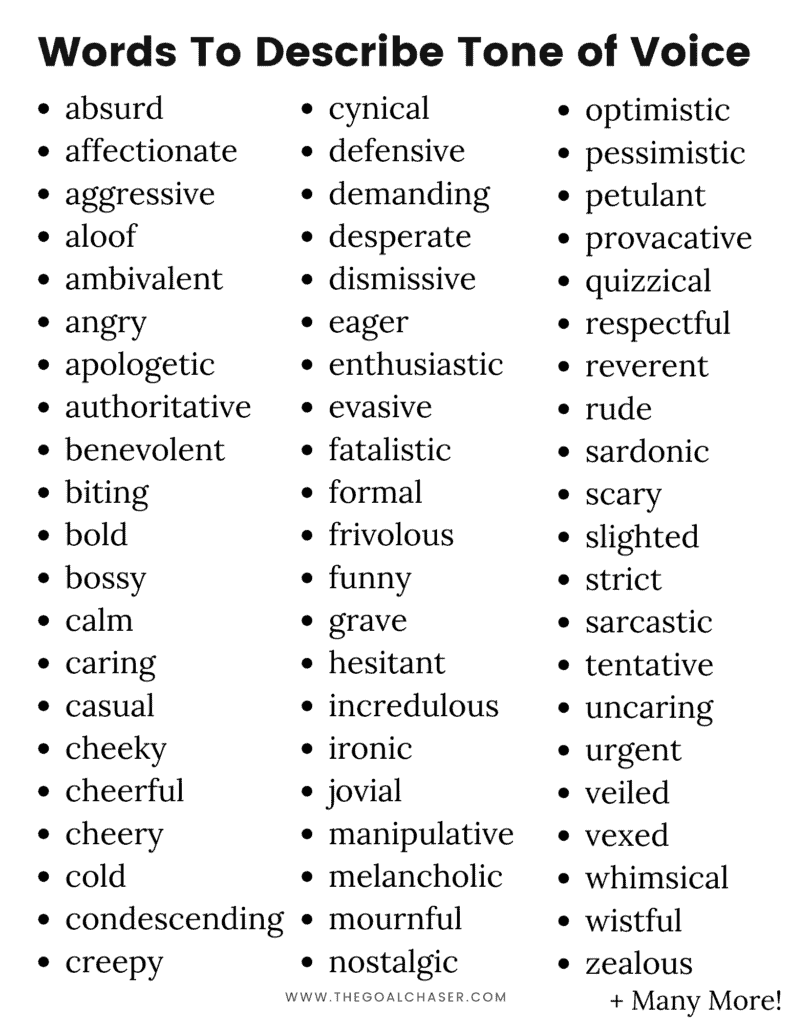60+ Words To Describe Tone Of Voice (With Meanings)
The words we choose to use carry significant weight.
However, the tone of voice, with which we deliver these words, often holds even more power.
It can transform a simple ‘hello’, from a warm greeting, to a cold acknowledgment.
The tone of voice conveys emotion, intent, and personality, making it a crucial aspect of both verbal and written communication.
To better appreciate the intricacies of tone, we have compiled a list of words that can be used to describe it, helping both readers, and writers, refine their communication skills.
Words to Describe Tone of Voice
Just some of the many words that can be used to describe the tone of voice include:
Absurd: Ridiculous or illogical to the point of being funny or bewildering.
Affectionate: Warm and loving. This tone exudes care, often seen in close relationships or endearing situations.
Aggressive: Confrontational and forceful.
Aloof: Distant, or detached. It’s a tone that suggests indifference or lack of interest.
Ambivalent: Mixed feelings or contradictory ideas about something. This tone suggests uncertainty or indecisiveness.
Angry: Expressing intense displeasure or rage. This tone can be aggressive and confrontational.
Apologetic: Showing regret or remorse. An apologetic tone often sounds sincere and contrite.
Authoritative: Confident and knowledgeable.
Benevolent: Kind and well-meaning. It’s a tone that offers comfort and assurance.
Biting: Harsh or cutting. This tone can sound sarcastic or caustic, usually with a sense of criticism.
Bold: Confident and daring.
Bossy: Assertive and domineering.
Calm: Peaceful and relaxed. This tone is even-tempered and suggests a lack of agitation.
Caring: Kind and compassionate.
Casual: Informal and relaxed.
Cheeky: Playfully impudent or irreverent.
Cheerful: Bright and optimistic. A tone that exudes happiness and positivity.
Cheery: Bright and joyful.
Cold: Lacking warmth or emotion.
Condescending: Speaking down to someone. This tone implies a sense of superiority or disdain.
Confident: Assured and self-reliant. This tone conveys a strong belief in oneself or in what’s being said.
Conversational: Informal and friendly, like a chat.
Creepy: Eliciting unease or fear.
Cynical: Distrusting or doubting the sincerity or goodness of people’s motives. A cynical tone often sounds skeptical and dismissive.
Defensive: Protecting oneself from criticism. This tone suggests the speaker feels threatened or challenged.
Demanding: Asking with authority.
Desperate: Showing a sense of urgency or hopelessness. The tone is heavy with emotion and often implies a need or want.
Dismissive: Showing lack of interest or belittling something.
Eager: Looking forward to something with enthusiasm. The tone is full of anticipation and excitement.
Enthusiastic: Full of excitement and eagerness.
Evasive: Avoiding directness. This tone can suggest that the speaker is hiding something or is unwilling to confront the topic directly.
Fatalistic: Accepting all things as inevitable. This tone suggests a resigned acceptance, often without hope for change.
Formal: Polite and impersonal. This tone follows conventions and is devoid of casualness or slang.
Frivolous: Light-hearted and not serious. This tone often makes light of situations and is playful in nature.
Funny: Humorous or causing laughter.
Grave: Serious and solemn. This tone indicates that the matter at hand is of utmost importance.
Hesitant: Showing a lack of certainty or sureness. The tone suggests doubt or reluctance.
Incredulous: Unwilling or unable to believe. This tone conveys doubt or skepticism.
Ironic: Saying one thing but meaning another, usually the opposite. This tone has an underlying hint of sarcasm or jest.
Jovial: Characterized by good-humored cheerfulness. This tone is hearty, friendly, and uplifting.
Manipulative: Calculating and controlling, often subtly.
Melancholic: Sad and pensive. This tone is heavy with sorrow or contemplation.
Mournful: Expressing sorrow or grief. This tone is filled with sadness, often due to a loss or disappointment.
Nostalgic: A sentimental yearning for the past. This tone reflects fondly on memories, often with a sense of longing.
Optimistic: Hopeful and confident about the future. This tone looks at the brighter side of things.
Pessimistic: Seeing the negative aspect of things. This tone anticipates the worst outcomes.
Petulant: Childishly sulky or bad-mannered.
Provocative: Causing annoyance, anger, or strong reaction intentionally. This tone challenges or confronts its audience.
Quizzical: Expressing or suggesting puzzlement. The tone indicates confusion or curiosity.
Respectful: Showing deference or esteem. This tone acknowledges the value or position of others.
Reverent: Feeling or showing deep respect. This tone is solemn and earnest, often used in religious or formal contexts.
Rude: Offensively impolite.
Sardonic: Grimly mocking or cynical. It’s a more scornful and mocking tone than mere sarcasm.
Scary: Directly threatening or frightening.
Slighted: Feeling or showing disrespect or undervaluation.
Strict: Rigorous and lacking flexibility.
Sarcastic: Mocking or ironic. This tone says something but means the opposite, often in a mocking manner.
Tentative: Not certain or fixed; provisional. This tone suggests carefulness, as if the speaker is testing the waters before fully committing to a statement.
Uncaring: Indifferent, lacking concern.
Urgent: Indicating immediate attention or action. This tone conveys a sense of immediacy and importance.
Veiled: Not expressed openly, often suggesting hidden motives.
Vexed: Annoyed or frustrated. This tone suggests displeasure or irritation.
Whimsical: Playfully quaint or fanciful. This tone is unpredictable and often light-hearted.
Wistful: Having or showing a feeling of longing or regret. This tone is subtly sorrowful but also hopeful.
Zealous: Full of, characterized by, or showing zeal; ardently devoted to a pursuit. This tone is fervent and impassioned.
How To describe tone of voice
Describing the tone of voice is all about capturing the emotional quality or character of spoken, or written, communication.
Tone conveys the speaker or writer’s attitude toward the subject and their audience.
Here’s a comprehensive approach to describing the tone of voice:
- Listen or Read Actively: Begin by paying close attention to what’s being said (or written) and how it’s being expressed. Listen for vocal nuances like pitch, volume, and pacing. In written form, pay attention to word choice, sentence structure, and punctuation.
- Identify the Emotional Quality: Think about the emotions or attitudes that are being expressed. Is the speaker joyful, sarcastic, somber, excited, etc.?
- Consider Context: Understanding the context can help in determining tone. A formal business setting might have a professional and serious tone, while a casual chat among friends could be more relaxed and jovial.
- Examine Word Choices: Specific words carry connotations that can set the tone. For instance, ‘lamented’ has a sadder connotation than simply ‘said.’
- Look for Literary Devices (for written content): Literary techniques like metaphors, alliteration, and hyperbole can provide clues about the tone.
- Check for Punctuation (for written content): Exclamation points might indicate excitement or urgency, while ellipses can suggest hesitation or uncertainty.
- Reflect on the Intended Audience: A speech or piece written for teenagers might have a different tone, than one intended for senior citizens.
- Compare and Contrast: Sometimes, it helps to contrast the tone with its opposite to make it clearer. For instance, if you’re not sure if a tone is optimistic, think about whether it sounds pessimistic.
- Be Specific: Instead of simply saying the tone is ‘positive,’ you might describe it as ‘enthusiastic,’ ‘elated,’ or ‘hopeful.’
- Consider the Purpose: What is the speaker or writer trying to achieve? Are they trying to persuade, inform, entertain, or express? The tone can provide clues.
Recognizing and understanding these various tones can enhance our interpretation of spoken or written messages.
They can help decode the intent behind the words, offering a richer understanding of the message being conveyed.
You may also like:






